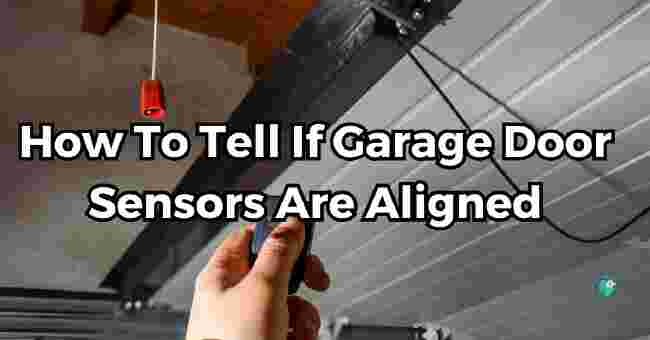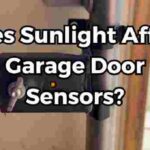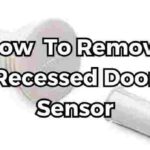Table of Contents
Have you ever wondered how to tell if garage door sensors are aligned? Chances are your safety sensor alignment is off.
I learned this lesson myself the frustrating way after a minor fender bender threw my sensors out of whack.
My door started flashing, beeping, and reversing randomly, even with no obstructions.
After researching how alignment works, I discovered an easy fix. Just a few tweaks and adjustments synced everything up again thankfully.
This experience taught me how crucial proper garage door sensors are for safely operating doors.
This guide will teach you all about garage door sensor anatomy, alignment diagnostics, and easy DIY realignment steps.
I’ll even cover when it’s smarter to call in a pro, like if the wiring or hardware needs more than an adjustment.
Manufacturers like LiftMaster, Genie, and Chamberlain also have great resources online.
Let’s start aligning.
Inside the Garage Door Sensor System
Garage door sensors, also called safety reversing sensors or photo eyes, are critical safety devices found on most modern openers.
Here’s a quick overview before we dive into alignment issues:
- What They Do: Sensors project invisible beams across the door opening. If a person or object blocks the path while closing, the door will immediately reverse open.
- How They Work: There is an emitter and receiver unit mounted on either side. The emitter blasts an infrared or photometric beam to the sensor across the way.
- Key Parts: Sensors feature lenses, indicator lights, wiring, mounting brackets and bolts. There are two types:
- Through-beam photoelectric sensors with separate transmitter/receiver
- Retroreflective sensors with a combined unit that bounces signals off a reflector
This diagram names the components:

Proper alignment ensures the sensors can “see” each other to communicate safely. If knocked out of whack, all sorts of wacky operation can occur.
How To Tell If Garage Door Sensors Are Aligned: Top Signs
While symptoms vary by opener brand and model, here are common signs of garage door sensors that need realignment:
- Doors Reversing While Closing
- This is the classic sign that beam communication is broken somewhere
- Sometimes reversing happens for no apparent reason
- Sensors Blinking or Flashing Oddly
- Various indicator light codes signal when alignment is off
- Rapid blinking when closing often indicates obstruction
- Lights Staying On, Door Won’t Close
- Another classic alignment symptom
- The sensors stay activated as if something is blocking
You may also experience:
- Noisy operation, grinding
- Manual release ropes fraying
- General safety and balance issues
Better align ASAP before problems worsen or cause injury!
Testing Sensor Alignment Like a Pro
Start diagnosis by visually checking if both sensors are pointing straight. Use indicator lights and run some simple alignment tests:
Analyze the Indicator Lights
- Most sensors feature an LED light that communicates status
- Check manual for exact meanings, but here’s a general guide:
| Light Signal | Meaning |
|---|---|
| Steady LED on | Properly aligned |
| Lights off | Misaligned, dirt on lens, dead or reversed polarity battery |
| Flashing LED | Obstruction detected |
- If flashing or staying solid on, sensors need adjustment
Do the Obstruction Test
- Start with door fully open
- Cover sensor lenses one at a time and operate door
- It should refuse to close when sensors are blocked
- If no change when covered, they’re definitely misaimed
Test in Manual Mode
- Disengage opener by pulling manual release rope
- Try closing door manually all the way
- It shouldn’t bind or hit sensors if aligned right
- Can help diagnose if it’s sensors or hardware causing issues
These methods should detect alignment problems accurately. Now let’s fix them.
Fixing and Adjusting Misaligned Sensors
Subtle vibrations or bumps can knock safety sensors out of whack over time. Realigning is often an easy DIY job.
Here are the steps:
- Inspect Sensor Wiring and Connections
- Clean the Lenses
- Adjust the Mounting Brackets
- Make Precise Alignments
1. Inspect Sensor Wiring and Connections
- Rule out loose plugs or broken wires first
- Pro tip: Spray connections with electric contract cleaner before reconnecting
2. Clean the Lenses
- Dust, dirt, spiderwebs can interfere with beam signal
- Lenses may just need a wipe down to realign
- Avoid wet cleaning methods that could damage system
3. Adjust the Mounting Brackets
- Loosen bolts to reposition assemblies left/right
- Ensure stable, vibration-free installation
- This tweaks angle just enough in most cases
4. Make Precise Alignments
- If adjusting brackets doesn’t realign.
- Twist or angle sensors incrementally
- Operate door to test alignment after each nudge
- Repeat until proper function restores
These realignment tips should solve most issues. But when should you call a garage door technician? Read on!
When You Need a Garage Door Tech
While many alignment issues are DIY-friendly, others require pro equipment and expertise:
- If Sensors are Physically Damaged
- Major troubleshooting and repairs needed
- May require total sensor replacement
- After Major Tracking or Hardware Adjustments
- Pros have laser alignment tools for precise realignment
- They’ll adjust full system back into balance
- For a Safety Inspection and Tune-Up
- Technician can diagnose other lurking issues
- Critical for garage door health and safety
Reputable companies like LiftMaster even offer online troubleshooting guides and videos for common problems.
But for iron-clad peace of mind, a professional garage door tune-up service yearly goes a long ways.
Finding a Good Garage Door Company
Where do you even start searching for a reputable garage door repair company? Here are handy tips:
- Check Reviews: Online review sites like Yelp offer candid reports on work quality and service.
- Ask Around: Neighbors and friends may have referrals or warnings to share.
- Research Credentials: Look for licensed, insured, and bonded services with factory tech training.
- Compare Quotes: Get bids from 3-5 installers before deciding; beware extremely cheap deals.
I’ve had great experiences with my local AAADoor Solutions franchise. Their techs are LiftMaster certified and very knowledgeable about both sensors and recent opener models.
Just remember – the most professional installation and maintenance means the safest garage.
Recap
To wrap up, let’s review the key takeaways:
- Garage door photo eye sensors are critical safety devices
- Misalignment can make doors reverse and refuse to close
- Indicator lights confirm if sensors can “see” each other
- Easy realignment tricks involve cleaning, tightening, adjusting
- When in doubt, call a trained garage door technician
While it may seem harmless, improper sensor function can allow doors to crush people and damage vehicles.
We all want the safest home possible for our families. Take the time to diagnose and care for this vital system.
FAQs
Should Both Sensors Be Green On Garage Door?
Ideally, both sensors on your garage door opener should glow solid green when properly aligned and working.
Green indicates the infrared safety beams are able to communicate clearly. If one or both lights are red, yellow, or flashing, it likely means the sensors are miscalibrated or obstructed.
Check your owner’s manual as some brands use different color codes. For example, Chamberlain sensors glow blue or purple when aligned.
As long as both units are the same color, you’re good to go. If not, a bit of DIY troubleshooting is needed.
How Do I Test My Garage Door Sensors?
You should test alignment monthly and also whenever you notice your garage door acting unusual.
The easiest DIY test is to block the sensors one at a time while operating the door. Place an object like cardboard or a broom handle in front of each sensor.
This simulates an obstruction. As you blocking them, try closing the door with the remote or wall switch.
It should refuse to close whenever either sensor’s path is interrupted. If the door closes regardless, your sensors need adjustment.
For other ways to confirm proper alignment, check the indicator lights or run a manual door test. And if issues persist, call in a garage door technician for a safety inspection.
How Do I Reset My Garage Door Sensors?
Resetting and recalibrating garage door sensors is simple. First, turn off power to the opener using the emergency disconnect pull rope or unplugging the unit.
Then inspect the sensors and wiring connections to ensure everything is still intact.
Clean the lenses with glass cleaner and microfiber cloth. Finally, turn power back on and manually adjust the sensor positions incrementally, testing after each movement, until the indicator lights show solid colors.
Run the door through a few open/close cycles to verify normal operation. You may need to repeat adjustment if they fall out of alignment again quickly.
If sensors must be reset frequently, vibration or instability in mounting could be the culprit.
How Do I Know If My Garage Sensors Are Working?
Check the indicator lights on each sensor unit – steady glowing lights typically means they are powered, aligned, and communicating properly.
Flashing lights or lights staying dark often signals an issue. You can also test function by blocking the sensors one at a time as you operate the garage door.
Place an object in their path and hit the remote button or wall switch to close the door.
It should stop and reverse every time if the safety beams are working right. No reaction when obstructed points to alignment problems or non-functioning sensors.
How Do I Know If My Garage Sensor Is Bad?
A few clear signs can confirm if one of your garage door photo eye sensors has failed and needs replacement.
If one unit shows no indicator light while the other glows steady, it points to a bad sensor.
You may notice the working unit’s light flashing constantly as it tries unsuccessfully to communicate with the faulty one.
Sporadic and inexplicable reversing when closing also indicates a potential dud. Check for corrosion, cracks, damage, or loose wiring connections on the suspect unit.
Try cleaning the lenses and realigning first. If issues continue, it likely needs professional replacement.
Many sensors fail due to dust/dirt accumulation or simple old age after 5-10 years.
What Is The Easiest Way To Align Garage Door Sensors?
The easiest DIY method for realigning garage door sensors is adjusting the mounting brackets.
You’ll notice one or both brackets has slots that allow pivoting and shifting the sensor units slightly.
Simply loosen the screws or bolts so you can nudge the sensors incrementally left or right.
Make very small movements and test operation after each adjustment. The key is patience – keep making micro-adjustments until the indicator lights show solid alignment.
Secure everything tightly so vibration doesn’t knock them out of whack again.
This small physical positioning change works great unless wires or hardware are damaged. You can also try lens cleaning or rebooting the system.
Can A Garage Door Work Without Sensors?
While it’s technically possible to operate a garage door without safety beam sensors, it’s extremely inadvisable due to danger and liability issues.
These sensors trigger automatic reversal upon obstructing objects, preventing damage, injuries, and accidents.
Operating without them violates building codes in most areas. Furthermore, opener manufacturers expressly warn against bypassing safety devices in manuals.
Doing so voids warranties if other parts subsequently fail. However, you can temporarily disconnect sensors when manually opening or closing doors for maintenance, then immediately reconnect them.
Overall, shelling out for a replacement is smarter and safer than running sensor-less long-term.
Why Is One Garage Door Sensor Red And The Other One Green?
Having one red and one green sensor typically signals they are out of alignment and unable to synchronize communication streams.
The exact meaning of color codes varies slightly by garage door opener brand. But as a rule, steady green lights indicate aligned sensors, while red means something is obstructing or interrupting the safety beams.
Flashing colors often mean realignment is needed. If cleaning lenses and resetting don’t solve the mixed colors, damage is likely the culprit. Inspect wiring, connections, and hardware mounts on both the red and green units.
Make incremental positioning adjustments to resynchronize. If problems persist, replacement of the errant sensor may be needed.
Don’t ignore mixed colors for long so you don’t compromise critical safety function.
How Do I Know If My Garage Door Sensor Is Broken?
A broken garage door photo eye sensor will have very obvious symptoms that differentiate from routine misalignments.
Check if one unit has no power light while the other glows normally. Also watch for lights that inexplicably flash even when beams aren’t obstructed.
Sporadic and mysterious door reversing while closing also signals potential sensor failure.
Physically inspect each unit for damage like cracks or loose wires that point to internal malfunctions.
Try cleaning and realigning, but typically damaged sensors must be fully replaced.
Installation is simple but precision tuning takes some practice. Rather than risk safety issues, seeking professional replacement and alignment of a broken sensor is smart.
What Color Should The Lights Be On Garage Door Sensors?
Ideal status lights for properly functioning garage door sensors are steady glowing green, blue, red, yellow, or purple depending on opener brand.
The key is that both units match colors when doors are closed. Flashing lights means obstructions, misalignments, dirt on lenses, or dead batteries.
If one light stays solid while the other blinks erratically, sensor damage is likely. If both stay dark, power connection issues are probable.
While light colors and meanings vary across manufacturers, the central rule is that both should sync up when aligned and communicating clearly.
If they don’t glow steady in tandem, it’s time for sensor troubleshooting and realignment.
What Makes Garage Door Sensors Fail?
The main causes of garage door safety sensor failure over time are dust/dirt accumulation and simple aging.
Road vibration or accidental knocks also slowly knock systems out of alignment, causing glitches.
While modern photo eye sensors are very durable, their electronic internals can fail after 5-10 years.
Dust clumps on lenses interrupt the crucial light beams between units so doors refuse to close all the way. Always wipe sensors clean before assuming they’re busted.
Hard-wired sensors also fall prey to critters chewing on insulation and wires or corrosion after prolonged exposure to weather elements.
Avoid sensor damage and extend operational lifespan through occasional cleaning, testing, and tuning by a pro.
Conclusion
Getting familiar with garage door sensor alignment equips you to handle symptoms confidently when they eventually crop up.
Whether it’s cleaning lenses, adjusting brackets, or determining when professional service is smarter, you now have the knowledge.
Properly functioning safety sensors are essential for injury prevention and operational longevity.
So test sensors monthly and tune alignment at the first sign of trouble. Empower yourself as a savvier homeowner.




